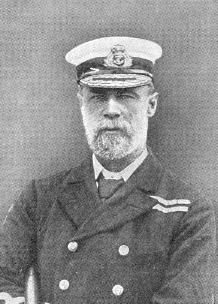Arthur Knyvet Wilson
| Sir Arthur Knyvet Wilson, Bt | |
|---|---|

Admiral Sir Arthur Wilson
|
|
| Nickname(s) | Tug, Old 'Ard 'Art |
| Born |
4 March 1842 Swaffham, England |
| Died | 25 May 1921 (aged 79) Swaffham, England |
| Buried at | St Peter and St Paul's Churchyard, Swaffham |
| Allegiance | United Kingdom |
| Years of service | 1855–1911 |
| Rank | Admiral of the Fleet |
| Commands held |
First Sea Lord Channel Fleet Experimental Torpedo Squadron HMS Sans Pareil HMS Vernon HMS Raleigh HMS Hecla |
| Battles/wars |
Crimean War Second Opium War Anglo-Egyptian War Mahdist War |
| Awards |
Victoria Cross Knight Grand Cross of the Order of the Bath Member of the Order of Merit Knight Grand Cross of the Royal Victorian Order Order of the Medjidie (Ottoman Empire) Order of the Dannebrog (Denmark) Order of the Netherlands Lion |
Admiral of the Fleet Sir Arthur Knyvet Wilson, 3rd Baronet VC, GCB, OM, GCVO (4 March 1842 – 25 May 1921) was a Royal Navy officer. He served in the Anglo-Egyptian War and then the Mahdist War being awarded the Victoria Cross during the Battle of El Teb in February 1884. He went on to command a battleship, the torpedo school HMS Vernon and then another battleship before taking charge of the Experimental Torpedo Squadron. He later commanded the Channel Fleet. He briefly served as First Sea Lord but in that role he "was abrasive, inarticulate, and autocratic" and was really only selected as Admiral Fisher's successor because he was a supporter of Fisher's reforms. Wilson survived for even less time than was intended by the stop-gap nature of his appointment because of his opposition to the establishment of a Naval Staff. Appointed an advisor at the start of World War I, he advocated offensive schemes in the North Sea including the capture of Heligoland and was an early proponent of the development and use of submarines in the Royal Navy.
Born the son of Rear Admiral George Knyvet Wilson and Agnes Mary Wilson (née Yonge), Wilson was educated at Eton College before he joined the Royal Navy as a midshipman aboard the second-rate HMS Algiers in 1855. He was present at the Battle of Kinburn in October 1855 during the Crimean War. He was transferred to fourth-rate HMS Raleigh on the China Station in September 1856 and then, following the loss of the Raleigh near Hong Kong, transferred to the second-rate HMS Calcutta and saw action in command of a gun in the naval brigade at the Battle of Canton in December 1857 and then at the Battle of Taku Forts in May 1858 during the Second Opium War. He was appointed to the steam frigate HMS Topaze on the Pacific Station in September 1859 and was promoted to lieutenant on 11 December 1861. After a tour in the steam frigate HMS Gladiator, he joined the gunnery school HMS Excellent at Portsmouth in April 1865. He became an instructor at the new Imperial Japanese Naval Academy at Yokohama in Japan in May 1867 and then at the new training ship HMS Britannia in January 1869.
...
Wikipedia
